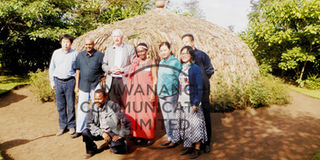TRAVEL : Meru cultural centre brings museum to life

The centre’s core objective is raising awareness and appreciation of the Meru culture (Varwa) – traditions and language for posterity. PHOTO | ELISHA MAYALLAH
What you need to know:
Located on the north eastern of Arusha City on the Momella road nearly 25 kms away, Meru cultural centre, is a tranquil place, one that offers visitors a chance to sample an unpretentious lifestyle and all that comes with an unpolluted village setting.
Styled entirely out of sustainable resources found locally, the simple environment and natural textures created a cultural appeal – such was the welcoming scenery at the Meru cultural centre recently.
Located on the north eastern of Arusha City on the Momella road nearly 25 kms away, Meru cultural centre, is a tranquil place, one that offers visitors a chance to sample an unpretentious lifestyle and all that comes with an unpolluted village setting.
Meru cultural centre is one of the tourist spots dedicated to cultural preservation through its museum and cultural activities near Arusha City.
This past week, I joined a small group of nature and history enthusiasts who were meeting in Arusha for the 2015 ICOM-ITC African workshop travelling to the area. We visited the Meru centre on a day trip organised by the Cultural Tourism Program of The Tanzania Tourist Board (TTB) and the National Museums of Tanzania.
With a hearty hello, our host Nkasiyoi Pallangyo treated us in a local Wa-Meru tradition. The Wa-Meru live around Mt Meru 4,566m, the second highest in Tanzania,
On arrival, before settling under the cool shade of the ee-Yeiyo boma, a traditional prayer was made. Here there is plenty of natural lighting just like the natural shades from the few trees in the entire space of the boma.
We settled and listened to Ms Nkasiyoi telling us the history of the Meru centre, which preceded the ee-Yeiyo cultural tourism enterprise.
Nkasiyoi Pallangyo created ee-Yeiyo in 2010, after living abroad for over 20 years, she returned to the native Meru village and into an almost extinct culture.
During the time she realized that most people preferred to converse in Kiswahili rather than Kimeru. Others did not see how Kimeru could be of any use to their children who did not even want to speak the language. One woman openly laughed at her for giving her children Meru names telling her that they would hate their names when they grow up.
To this day, she strongly believes that Meru’s history, culture and language are the identity. An identity that must be promoted and preserved for future generations.
“We should not let our children assume other people’s identity,” she quickly adds.
In addition, she noticed that a lot of children and young people could not carry on a conversation in Kimeru. She was saddened by the fact that almost everyone, young and old, thought anything western was better.
The main focus then was to highlight the unique cultural wealth of the tribe, and economic and environmental concerns of the local community.
After a success story on the ee-Yeiyo cultural tourism project the full-fledged Meru centre was created to package the centre’s core objective of raising awareness and appreciation of the Meru culture (Varwa) – traditions and language for posterity.
Critical in their awareness campaign, Nkasiyoi said the present generation has been shying way from tradition names, and she opines that local names should be upheld to preserve the culture.
And the Meru centre, according to her, has worked consistently to sensitize the locals to like and promote their names. Names are traditionally used to tell the story of the family, she said.
Meru tribe which is believed to have been part of the Wachagga from Machame in Kilimanjaro Region shared some of the cultural aspects with the Maasai. Nkasiyoi told us that after tribal wars between the Meru and the Maasai was over, in which the Maasai used to steal cattle and women from the Meru, slowly normalcy returned to the land where both the Meru and Maasai settled peacefully.
In most of the Meru villages in Arumeru District in Arusha Region, they live side-by-side with the Maasai. And our host was quick to add that there have been many cases of intermarriage between the Meru and the Maasai for several decades now.
After the briefing we were invited to take tea in traditional cups. Wa-Meru use cattle horns as cups to serve and drink tea. Each one of us was happy to enjoy our afternoon tea from the horn cups.
Next was our visit in the designated traditional houses. The architecture of the individual traditional houses is simple. A blanket of dry banana leaves which act as a wall and roof appear in an exclusive khaki colour.
First we walked in the family man’s house where a woman would only visit on invitation and later walked into the family mother’s home where she stays with the siblings. In the surrounding area the sprawling ground includes a communal area and a storage hut nearby.
E-mail: [email protected]




